These days, you would be hard-pressed to find an architect who hasn’t heard that buildings are responsible for nearly 40 percent of the world’s carbon dioxide emissions, which trap the heat in the atmosphere and warm the earth. Some may still assume that operating energy is the sole source of these greenhouse gases. But a significant chunk, 11 percent of annual emissions, are due to construction and all the processes that lead up to it—including manufacturing materials into products and transporting them to the site. This CO2 is sent into the atmosphere well before someone puts the key in the door and switches on the lights for the first time.
A community of design professionals has been working hard to sound the alarm about these “up-front” or, as they are more commonly known, “embodied” emissions. With the world’s building stock expected to double by 2060, they are making the point that it is critical to rein in these greenhouse gases if we want to limit the global temperature rise to 1.5 degrees Celsius and avoid climate calamity. And, fortunately, their warnings are gaining urgent attention.
Architect and structural engineer Kate Simonen, director of the Seattle-based Carbon Leadership Forum (CLF), an organization founded a decade ago to tackle embodied emissions, says there is growing recognition that the window for taking action is narrowing. “Now people can see all the way to 2050,” she says, referring to goals set by Architecture 2030, the nonprofit established by architect and climate activist Ed Mazria, which calls for complete decarbonization of the built environment by midcentury. There is new awareness that global warming is a near-term problem, says Amy Seif Hattan, vice president of corporate sustainability at engineering firm Thornton Tomasetti, adding that “we don’t have to wait to operate buildings to make a difference.”
For most laypeople, “carbon emissions” is an abstract concept—one that is far less familiar than energy consumption. “You don’t get a carbon bill,” points out Pauline Souza, a partner and director of sustainability at San Francisco–based architecture firm WRNS Studio. Yet even though the global-warming potential (GWP) of a particular material or activity might be difficult to visualize, it can be quantified—measured in tons of CO2 or CO2e. The latter term refers to carbon dioxide “equivalents,” meaning other heat-trapping gases such as methane or nitrous oxide, but all are expressed in terms of the quantity of CO2 that creates the same level of warming. This footprint is calculated through a process known as life-cycle assessment (LCA), which considers a product throughout its lifespan—from extracting raw materials, manufacturing, and use to disposal—and evaluates its effects in several environmental-impact categories, including the effect on air and water quality and GWP.
Such an analysis can be highly rigorous, like the report that the tech-forward construction company Katerra commissioned from CLF for its Catalyst Building—a 150,000-square-foot academic structure for Eastern Washington University under construction in Spokane and made of carbon-storing mass timber. Designed by Vancouver-based Michael Green Architecture (now owned by Katerra), it is the first project to use the cross-laminated timber (CLT) components manufactured in the factory that Katerra recently opened nearby. The analysis drills down into the environmental performance, not only of the building, but of the CLT supply chain, examining such particulars as forestry operations, lumber transport, the factory’s energy source, and the steps involved in fabricating the mass-timber elements, including finger jointing the wood, adhesive application, and pressing. The aim of the study was to identify “hot spots,” or areas of potential improvement, while demonstrating Katerra’s environmental credibility to prospective customers, says Craig Curtis, the company’s head of architecture and sustainability.
The level of resolution of the Katerra analysis might sound daunting, but it is an academic study, points out Simonen. The embodied-carbon accounting that design and construction firms perform is generally much simpler and is often aided by one or more of a growing body of digital estimating tools. Some of the well-established tools include the Athena Impact Estimator, best suited for early design phases, and Tally, a Revit plug-in developed by architecture firm KieranTimberlake and tailored for design teams working collaboratively in BIM. Late last year, the CLF, in partnership with construction company Skanska and the software developer C-Change Labs, among others, launched the free, open-source Embodied Carbon Construction Calculator, or EC3. Focused on the specification and procurement phases of projects, it allows the comparison of similar materials from different suppliers. The recently released Beacon, a tool developed by Thornton Tomasetti, analyzes and compares different structural systems.
Besides the new array of software, recent changes to green-building certification programs are pushing project teams to consider embodied carbon. Starting with LEED v4, launched in late 2013, the rating system has included credits for conducting a whole-building life-cycle assessment (WBLCA)—which generally encompasses the structure and enclosure—and then reducing embodied carbon. But in the latest version, v4.1, now in beta testing, the credits have been tweaked so that projects can earn one point simply for performing a WBLCA, and then gain additional points for reducing the embodied-carbon footprint. The idea, according to the U.S. Green Building Council, which manages the rating system, is to encourage using a life-cycle assessment (LCA) to inform design decisions.
Before moving into their offices (1) in a former beer-bottling plant (2) in Philadelphia, KieranTimberlake made extensive modifications. Even so, an LCA showed that the renovation’s effects, across several environmental-impact categories, were much lower than new construction would have been (3).
Click chart to enlarge
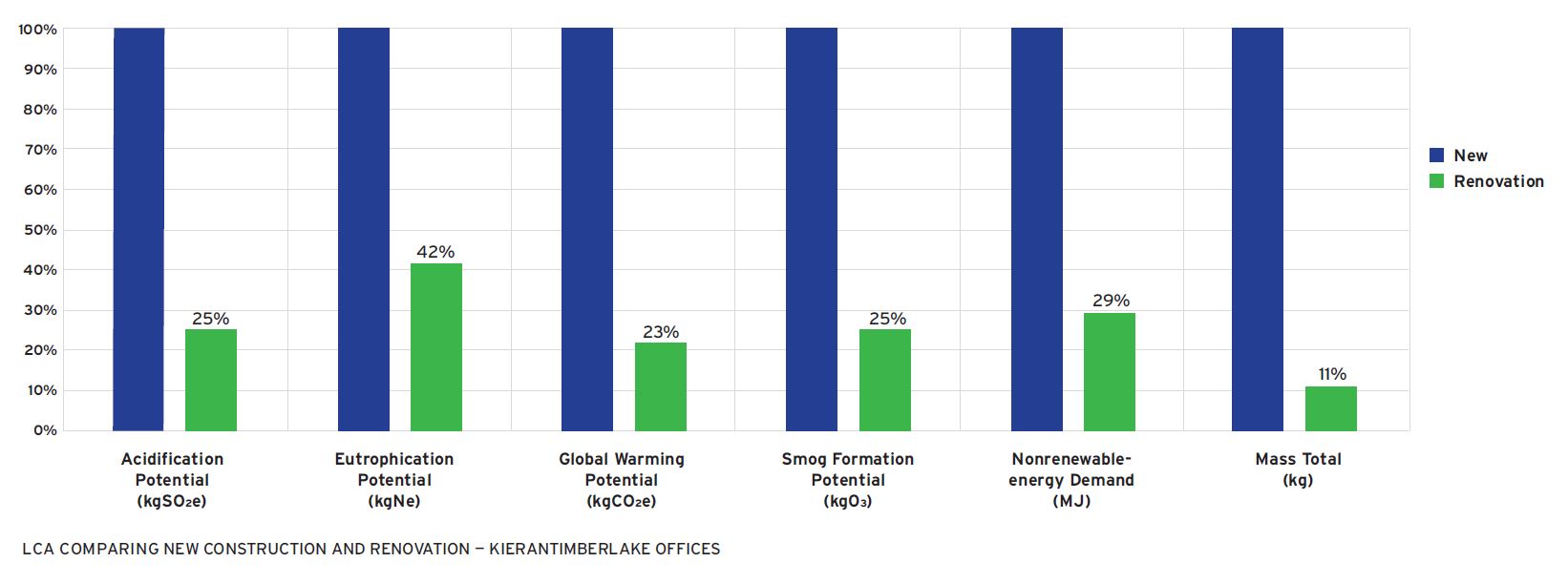
3
Image courtesy of KierantTimberlake
The Living Building Challenge (LBC), meanwhile, has included embodied-carbon reduction among its “imperatives” since its inception in 2006. But two years ago, the International Living Future Institute (ILFI), which oversees the LBC and several other related initiatives, introduced a separate Zero Carbon program encompassing both operational and embodied emissions. Certification of new buildings entails disclosure of all the embodied carbon associated with the materials and construction of a project, a 10 percent reduction, and the purchase of environmental offsets to bring net embodied emissions to zero. The program is proving popular with corporations with strong decarbonization commitments, according to Andrew Lee, director for carbon and energy at ILFI. Microsoft, for instance, says it will pursue the certification for modernization projects at its Silicon Valley and Puget Sound campuses as part of an aggressive plan announced in January to be carbon negative by 2030, and by 2050 to remove all the carbon the company has emitted since its founding 45 years ago.
Programs like LEED and LBC are voluntary. But some North American jurisdictions have already moved to make embodied-carbon reductions obligatory. In January, the Buy Clean California Act, which requires state agencies to take the GWP of certain building materials into account on state-funded projects, went into effect. Washington State’s lawmakers are actively considering “buy clean” legislation. Last spring, Vancouver published an ambitious Climate Emergency Response plan that includes a target for a 40 percent reduction in embodied carbon for new construction by 2030, compared with a 2018 baseline. And in November, the board of supervisors in Marin County, California, approved a low-carbon concrete code that will apply to both public and private construction. “It won’t be long before such regulations proliferate,” predicts Stephanie Carlisle, a principal at KieranTimberlake. “Architects will have to comply.”
To develop or enhance their embodied-carbon literacy, some design firms are analyzing their own completed projects—projects that were not necessarily designed with embodied carbon in mind—to try to better identify opportunities for reductions on future work. Thornton Tomasetti recently published the initial results of an ongoing multiyear survey of structures it had designed. It found the highest concentration of embodied carbon in floor slabs for most building types, in the foundations of aviation facilities, and in the columns for skyscrapers. “As you go taller, the columns can get massive,” explains Duncan Cox, a senior associate in the London office. Making structures more efficient by using less material is one way reductions could be achieved. Such savings could be significant, since up to 70 percent of a building’s embodied emissions is contained in its structural system, says Cox.
With so much carbon locked up in a building’s bones, renovation and adaptive reuse make undeniable sense as emissions-reductions strategies. Carlisle points to her own firm’s offices in Philadelphia’s Northern Liberties neighborhood, in a former beer-bottling plant built in 1949. Before moving into the two-story, 60,000-square-foot masonry-clad steel-and-concrete structure in 2013, KieranTimberlake made changes that included replacement of the windows and the roof, the addition of raised access floors, and the construction of interior partitions, tracking and evaluating design options via BIM and Tally. Despite the extensive modifications to the old bottling plant, the revamp’s embodied carbon was only about a quarter of what it would have been had the firm opted to construct a new building.
Renovations, can, of course, be carbon-intensive—particularly those performed on the same space multiple times over the life of a building, such as tenant improvement projects—but, so far, there is little industry data available to help quantify the impacts of cyclical remodeling. The Seattle-based architecture firm LMN wanted to get a better handle on the cumulative effects of such projects, which are about 10 percent of their work, so they analyzed renovations to their own office building—a 17-story International Style tower designed by SOM in the late 1950s. The concrete-framed edifice was a good candidate for such an exercise, since LMN had drawings, specifications, and other documentation for the changes to the space it occupies—currently about 2.5 floors—and for a curtain wall replacement that the firm designed in the 1990s, explains Kjell Anderson, director of sustainability.
Click chart to enlarge

LMN's study revealed that the cumulative embodied-carbon footprint of the remodeling projects was greater than that of the structure, the original envelope, and a new curtain wall combined. Image courtesy of LMN
Taking into account carbon reductions achievable with current construction practices, and assuming that all the tenants renovated their spaces with the same frequency as LMN, and with similar design strategies and materials, the results of the analysis were a surprise: they showed that the total embodied emissions of interior modernizations over the past 60 years surpassed the combined embodied-carbon footprints of the structure, its original envelope, and the new curtain wall. And the study probably understates the true impact of the renovations, says Anderson. It is based on LMN’s workspace planning, with no enclosed offices, which is less carbon-intensive than one with many interior partitions. But the investigation helps the firm make the case with tenant improvement clients for low-embodied-carbon strategies, including detailing for disassembly, reusing or refurbishing existing furnishings, and for open-plan layouts.
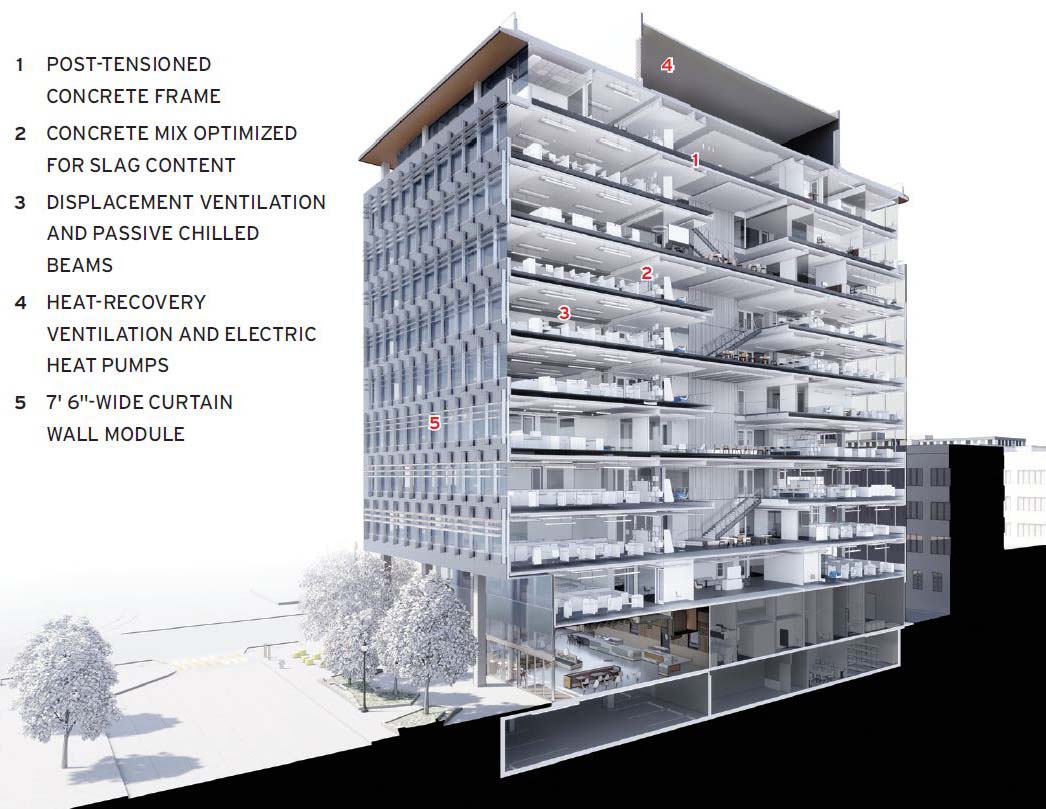
Section/Perspective - Clifford L. Allenby Building.
ZGF tweaked the concrete mix for the Clifford L. Allenby Building in Sacramento (right). The mix specification, along with other strategies, helped reduce the project’s embodied carbon by nearly 25 percent. Image courtesy of ZGF
One target of intense scrutiny by advocates for embodied-carbon reductions is concrete. By some estimates, Portland cement, concrete’s key ingredient, is responsible for 8 percent of greenhouse-gas emissions globally—in part because so much of it is used (an oft-quoted detail is that concrete is the second-most consumed substance on earth, behind water) and partly because of the processes involved in its manufacture. While several startup companies are investing in technologies that promise to transform concrete into a material that sequesters carbon (see sidebar, page 106), many design teams are using less exotic methods to trim the embodied emissions on their projects. Portland, Oregon–based ZGF Architects, for instance, cut embodied carbon by nearly 25 percent on its Clifford L. Allenby Building, an 11-story, 360,000-square-foot California state office block in downtown Sacramento, slated for completion in December. Much of the reduction is due to replacement of a portion of the cement with fly ash and slag (supplementary cementitious materials, or SCMs, that are waste products of coal combustion and steel-making respectively). Using an LCA tool that ZGF developed specifically for concrete, and working with local architect Lionakis and the design-build contractor Rudolph and Sletten, the firm fine-tuned the mix specifications to achieve targets for compressive strength and GWP. Other strategies for shaving embodied emissions on the project, which is on track for LEED Platinum, include wider curtain wall modules to reduce aluminum content and a post-tensioned frame, which allows for thinner slabs and—because the resulting structure is lighter—also permits smaller footings.
Some firms are finding that it can be tricky to balance goals for operating energy and embodied carbon. WRNS Studio encountered this challenge on its Janet Durgin Guild & Commons at Sonoma Academy in Santa Rosa, California. Completed in 2018, the 19,500-square-foot, two-story steel-framed structure, encompassing media studios, makerspaces, offices, and student dining, with an all-electric commercial kitchen, is built into a slope. This partially below-grade configuration meant that about one-third of the building’s exterior envelope would be a retaining wall, typically constructed of poured-in-place concrete or concrete masonry units (CMUs). “This was great for our window-to-wall ratio, but not for our embodied-carbon footprint,” says Souza. The firm’s solution was to build the retaining wall with a combination of locally sourced reduced-cement blocks and standard CMUs. The approach cut the GWP of the retaining wall by about 32 percent. WRNS also opted for low-embodied-carbon materials for other parts of the building, using CLT for part of the roof instead of metal deck and reclaimed cedar for some of the siding. But because of the necessary below-grade structure, the building’s carbon-use intensity comes in at about 52 kilograms of CO2e per square foot, which is higher than the firm’s other recent educational projects. The building is, however, operating at net positive: photovoltaics (PVs) on its roof and on a neighboring building supply a surplus of electricity, even covering the demands of the energy-intensive food preparation facilities.

Sonoma Academy is built into a slope, which helped with the envelope’s thermal performance but required a carbon-intensive retaining wall. Image courtesy of WRNS
Click chart to enlarge
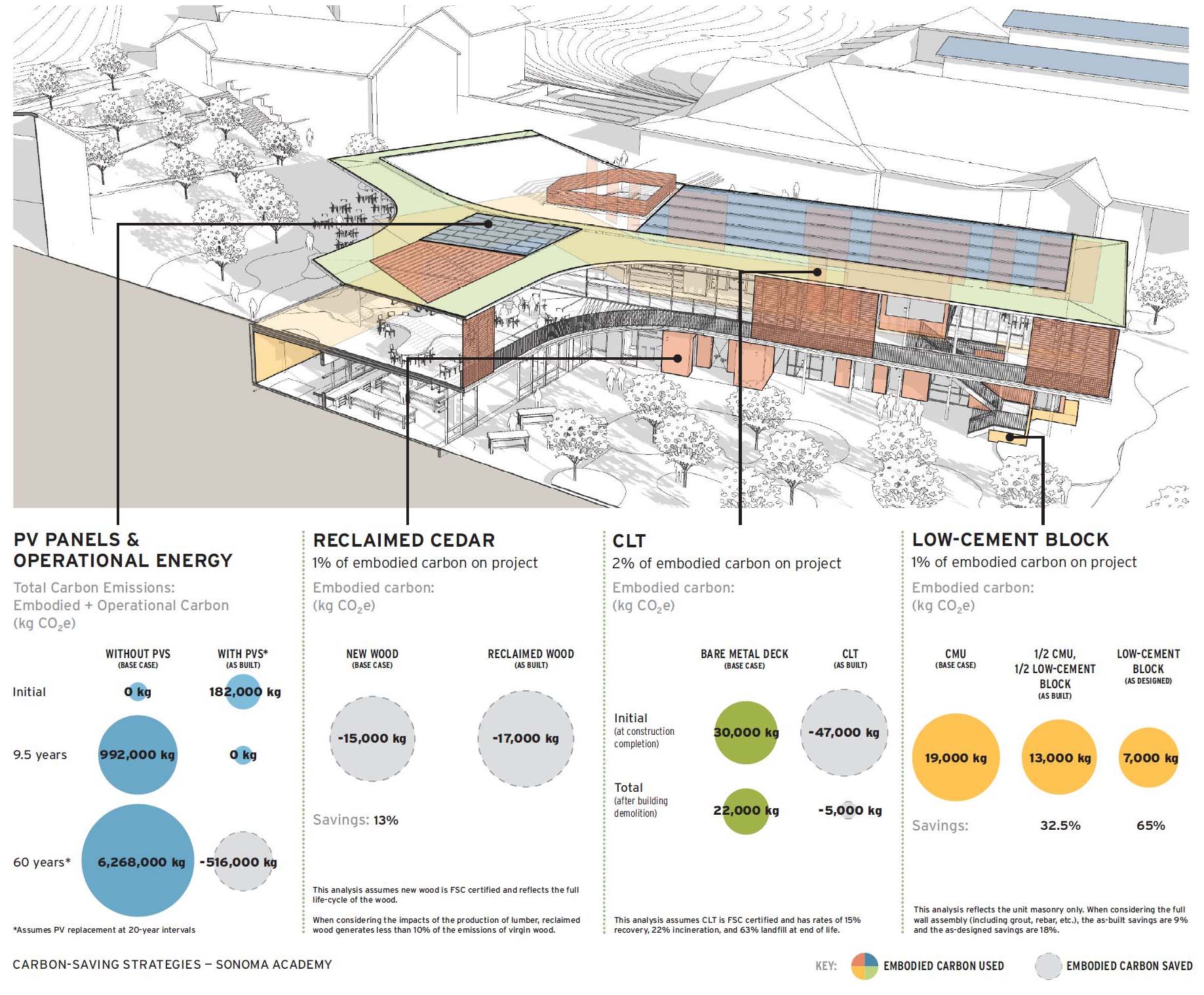
The project employed several low-embodied-emissions strategies, including using low-cement block in place of some traditional CMU. Image courtesy of WRNS
Katerra encountered some of the same push and pull between operating efficiency and embodied emissions on its Catalyst project. Like the Sonoma Academy building, Catalyst has net zero energy aspirations, but with off-site PVs. One of the revelations of the CLF study was that some of the buildings’ smallest elements are responsible for outsize embodied emissions. For instance, the facade system’s insulated metal panels and aluminum clips—part of an assembly that includes CLT and terra-cotta—have a high GWP, given that they represent a small proportion of the materials used on the project by mass. Curtis says the company felt it could not compromise on these components, since they were critical to the envelope’s thermal performance and will help the building achieve its operations goal.
Even though it includes some high-emissions elements, Catalyst will be nearly embodied-carbon-neutral. According to CLF’s calculations, the project’s timber stores 204.4 kg of CO2e per square meter, which comes very close to the building’s overall global-warming potential of 207 kg of CO2e per square meter. However, the report cautions that “one could say that the biogenic carbon storage practically offsets the impacts of construction, at least in the near-term before the wood decomposes in a landfill at end-of-life.” Simonen explains that the disclaimer is due to a host of factors, including unknowns like how long the building will be in use, and that accounting for carbon-storage capacity can be complex. “Did the carbon storage take place in the past 40 years, when the tree was growing, or will it take place in the future, when a new tree is planted?” she asks rhetorically.
Despite the proviso, the Catalyst project demonstrates that there is real potential for carbon-neutral or even carbon-positive buildings—at least for small or medium-size structures. “We don’t have the capacity to build that way at scale—at least not yet,” says Simonen. But she points to exciting innovations in materials—not only for wood, but for other products, including those made with agricultural waste, and highly experimental ones like concrete that would be “grown” from bacteria. “What motivates me is the possibility that buildings will be more than ‘less bad,’ ” she says. “That they can be part of the solution.”
Continuing Education

To earn one AIA learning unit (LU), including one hour of health, safety, and welfare (HSW) credit, read “Carbon Crackdown,” and the following supplemental material:
- New Technologies Help Concrete Go on a Greenhouse-Gas Diet
- LCA Practice Guide (through page 12; introduction only)
Then, complete the quiz at continuingeducation.bnpmedia.com.
Learning Objectives
- Define and explain the difference between “embodied carbon” and “operational carbon.”
- Describe how embodied carbon is measured.
- Describe low-embodied-carbon construction strategies.
- Discuss new technologies for sequestering carbon in concrete.
AIA/CES Course #K2003A

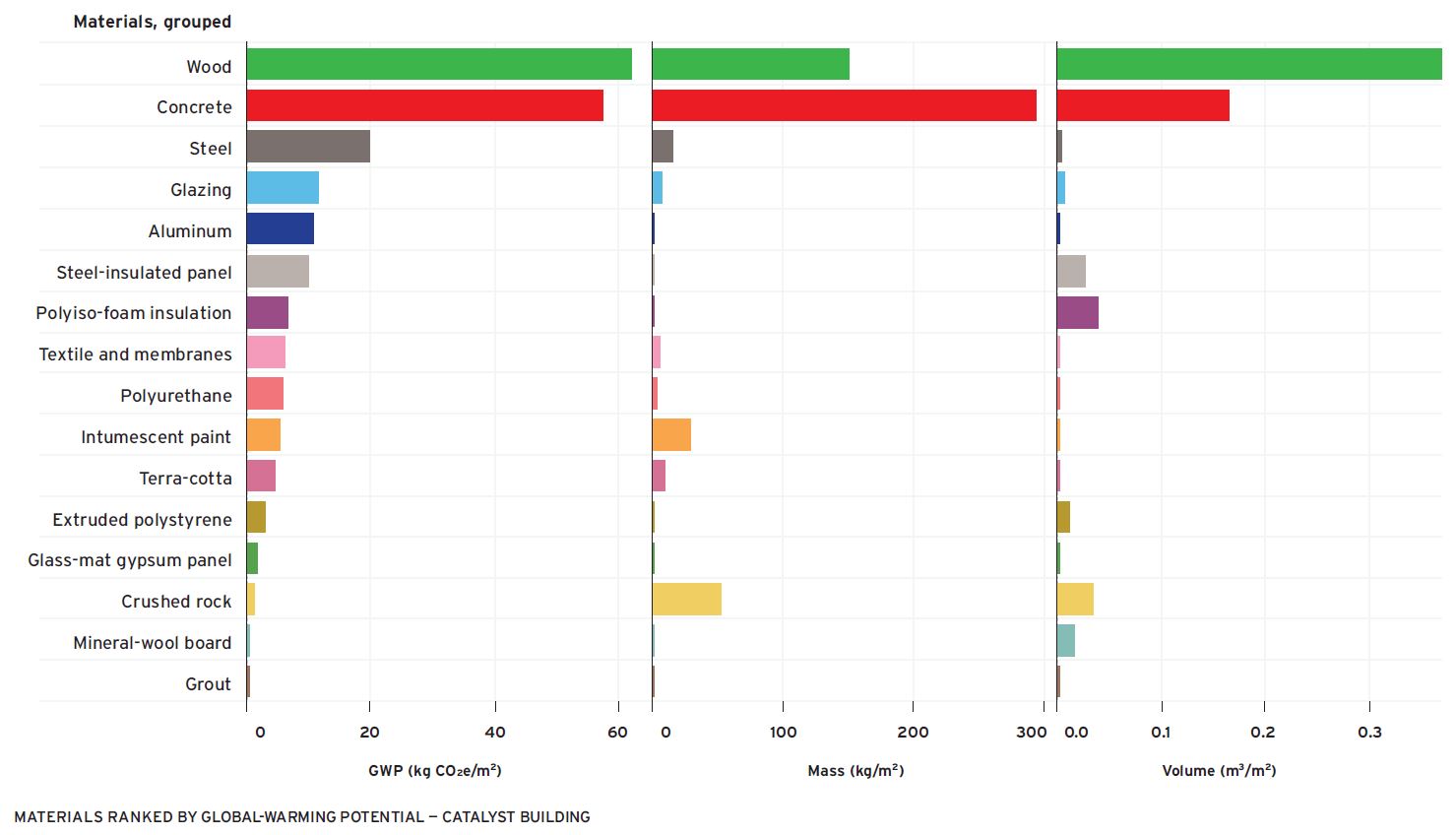
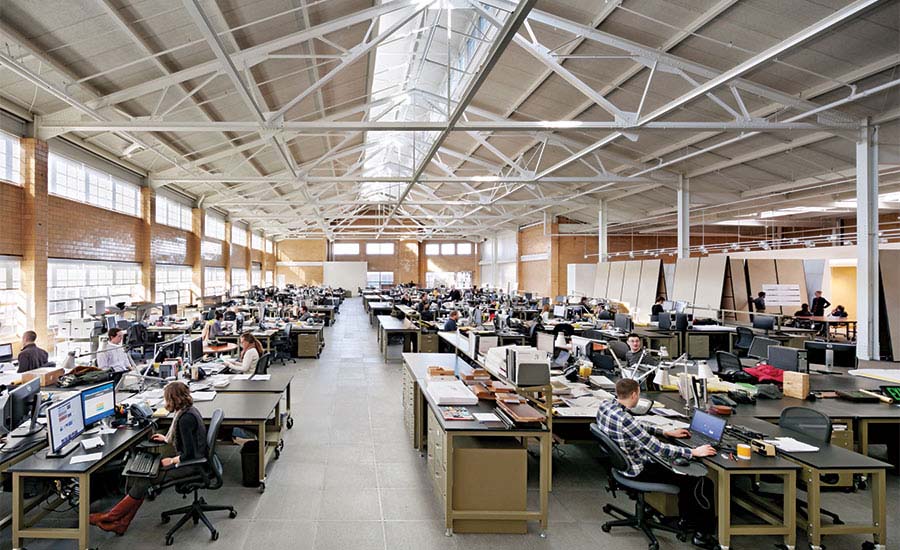
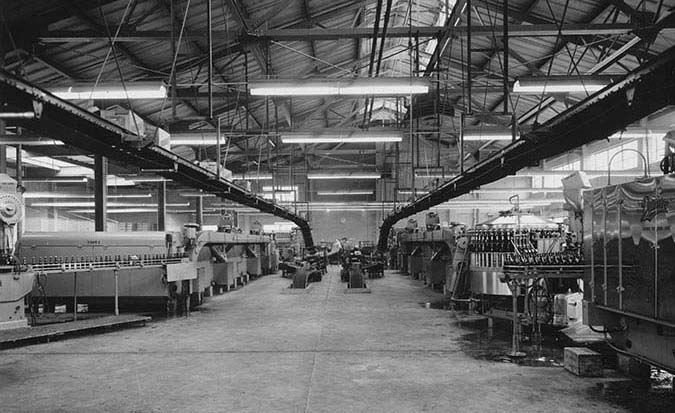


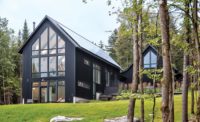

Post a comment to this article
Report Abusive Comment